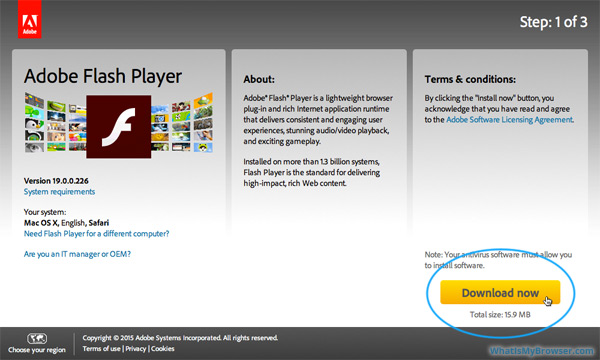

- #Flash player install for mac for mac#
- #Flash player install for mac update#
- #Flash player install for mac software#
This Safari-alternative ships with a Flash plug-in embedded in the browser. If you need to view a Flash-enabled page in a pinch, you can install and launch Chrome. (Note: if you don't find these three files in "/Library/Internet Plug-Ins/" they may be hiding in "~/Library/Internet Plug-Ins/".) The next time you relaunch Safari or Firefox, Flash will no longer be enabled.

Or if you really want to kill Flash, toss these files into the Trash. Once you are in the "Internet Plug-Ins" directory, make a new folder called "Disabled Plug-Ins." Move the "Flash ugin," "flashplayer.xpt" and "NP-PPC-Dir-Shockwave" files into your new "Disabled Plug-Ins" folder. When prompted, enter "/Library/Internet Plug-Ins/" and click "Go" to switch to the appropriate location on your system. To get there, switch to the Finder and select "Go to Folder." from the "Go" menu. Most often, the Flash plug-in can be found in the "Internet Plug-Ins" folder on your system's hard drive.

Whether you wish to conserve electricity, silence overactive cooling fans, boost the security of your browsing experience or protest against the use of media plug-ins, you can easily remove Adobe Flash from your Mac. Personally, my MacBook often sounds like it's preparing for space flight when I visit pages that use Adobe's plug-in. In the ensuing brouhaha, Ars Technica discovered Flash cut battery life by up to 33 percent on the MacBook Air and possibly other MacBook models.
#Flash player install for mac update#
#Flash player install for mac software#
As a reminder, antivirus software is required on any desktop or laptop connecting to NYU-NET. Install NYU–sponsored antivirus and malware protection software.This remains one of the best ways to protect yourself from malware. Update your OS, browsers, browser plug-ins and applications as soon as updates become available.If you detect any of the above-referenced files, and you’d like assistance with their removal, please contact your local IT Admin. Look for files or folders with the following names:.Look for files with the name Player.dmg (or Player #.dmg – where the # is a number) in your Downloads folder.For help verifying the latest Flash plug-in, and information re: where to get trusted Adobe updates, please see:.Therefore, it is recommended that you forego the installation of Flash, if possible Many sites have stopped relying on Flash because Adobe plans to discontinue it, and will not be releasing security updates for Flash after 2020.Google Chrome has a built-in version of Flash which updates automatically.With respect to Adobe Flash, please be advised of the following: The following is a screenshot of a site distributing CrescentCore masquerading as Adobe Flash Player:
#Flash player install for mac for mac#
For Mac users who are not running in a VM environment and who are not using antivirus malware protection software, a LaunchAgent will begin to install when you click Update or Download Flash. Notably, if this malware detects that it is running in a VM environment or if it detects that antivirus malware protection software is running on a device, the malware will simply exit. This malware functions as a trojan horse that will install malicious Safari extensions, rogue disk cleaners and possibly more malware. Mac malware dubbed CrescentCore, which is available through Google search results and numerous sites, masquerades as an updater or installer for Adobe Flash Media Player.


 0 kommentar(er)
0 kommentar(er)
